Let’s’ take a 1911 frame, shall we? We’ll expertly stuff the frame with the necessary goodies and we’ll add a set of grip panels that makes it, well, different from other frames. Now, let’s add a stainless-steel slide with the necessary components and a three-dot sight system. Let’s call this unit the Stainless II model.
Let’s take that same frame and change the grip panels. Atop the frame, let’s install a stainless-steel slide with all the goodies, but let’s change the sights to night sights and call the pistol the Stainless TLE II.
Again, let’s take that same frame and change the grip panels. But this time let’s use a carbon-steel slide with a three-dot sighting system and keep the same match barrel and bushing that we did for the other two pistols. Let’s call this pistol the Custom II and make it two-toned.

That seems to be exactly what Kimber did when creating these three pistols. And, why not do that? Why not take one frame, change a few components to tailor it to a specific design, and sell it as a different model. After all, a 1911 bare-bones frame is still a 1911 bare-bones frame, right? It’s what is done to the frame and slide that sets one apart from another, and more importantly is how well what is done is done. Kimber, among others to include COTS and custom gun makers, seems to be doing things 1911 right for a very long time.
If you have read some of my reviews you will no doubt know that I have succumbed to the call of many 1911-based pistols. You may also know that my EDC has been a Rock Island Armory (Armscor) 1911 FS Tactical for many years. This pistol was selected on several factors; cost-to-benefit ratio, reliability, and accuracy. It is, however, time to replace the “Rock” and this article is about its replacement, the Kimber Custom II in the same .45ACP caliber.
There were plenty of other 1911-based pistols to choose from and some I have and most I don’t have. I have spent a lot of time pondering about what to replace the “Rock” with, reviewing what I have ‘in-house’ versus what I don’t have. One pistol came back at me virtually every time even though I have several Kimber pistols in the collection, the Kimber Custom II. Much has been written and videoed about this pistol so there was a lot of information on it to read and view. Everything that I read or viewed about the Kimber Custom II was positive albeit not using the provided magazine was mentioned on more than one occasion.
Basic information for the Kimber Custom II is shown below.
Product Information:
- Cartridge: 45 ACP
- Capacity: 7+1 Round
- Weight: 38 Ounce (unloaded)
- Barrel Length: 5 Inches
- Action Type: Semi-Automatic
- Trigger Type: Single Action
- Safety: Thumb/Grip
- Threaded Muzzle: No
- Barrel Finish: Stainless
- Front Sight: Fixed Blade with White Dot
- Rear Sight: Fixed with White Dot
- Frame Material: Stainless Steel
- Grip Material: Wood
- Frame Finish: Stainless
- Magazine Quantity: 1
- Slide Finish: Black
- Grip Style: Checkered
- Grip Color: Rosewood
- Compensated: No
- Country of Origin: United States of America
- Trigger Pull: 4-5 Pound
- MSRP: $910
So, why a Kimber product when there are many others to choose from, including the very similar Springfield Ronin and Colt Combat Elite 45 ACP Centerfire Pistol? Kimber’s reputation for quality has been hit and miss over the years. I own several of them with only one giving me fits, the Kimber Camp Guard 10mm. However, even that one is coming around to becoming as reliable as it is accurate. I’ll just say that it has taken me to perform some finishing work and different magazines to make it reliable. With that said, tweaking to one degree or another on some of my non-Kimber 1911s was also necessary at times. A Kimber 1911 is no different from any other semi-automatic pistol in regard to proper lubrication, recoil spring maintenance/replace, parts replacement/adjustment, determining pistol/ammo combination, etc.
The bottom line was that the Kimber Custom II was available and others like it were not (at this time).
As usual, I was able to obtain the Kimber Custom II at a price lower than MSRP. Price-wise, the Kimber Custom II is comparable to many other 1911-based pistols in its class ( Colt Combat Elite 45 ACP Centerfire Pistol and Springfield Armory Ronin, for example) and maybe even below the cost of other 1911-based pistols in the same class (for example, the Ruger SR1911).
An initial look at the Kimber Custom II reveals not much difference from what is currently available in the 1911 line. So, what made me want the Kimber Custom II, aside from wanting to write another article about just another 1911?
With the exception of the Kimber Camp Guard in 10mm, I have had no issues with any Kimber 1911-based pistol that I have (9mm and .45ACP), the quality is excellent, the caliber correct, and the Kimber Custom II has two features that I liked over the Springfield Armory Ronin, 3-dot sights and a metal trigger. I’ll get to those later.
The Kimber II is a two-toned pistol, black carbon-steel slide over a stainless frame, which means it is not a lightweight pistol. At 2.375-pounds dry, the pistol places some weight on the hip. That’s fine, as I am used to that. By comparison the ‘Rock’ weighs in at 2.49 lbs. dry.
Setting the weight thing aside, let’s take a look at the Kimber Custom II.
The Upper
The slide is described by Kimber as a brush polished, black with no mention of what actually comprises the finish. The slide exhibits a contrast with highly-polished flats and flat black top and lower guide rod housing. According to my readings, however, the finish is not a spray and bake like KimPro II. Kimber’s black oxide finish wears well and is significantly stronger than bluing. Black Oxide adds about 5 to 10 millionths of an inch to the dimension of a part. It also penetrates to an approximate depth of 5 to 10 millionths of an inch. How well it will wear? Only time and use will tell.
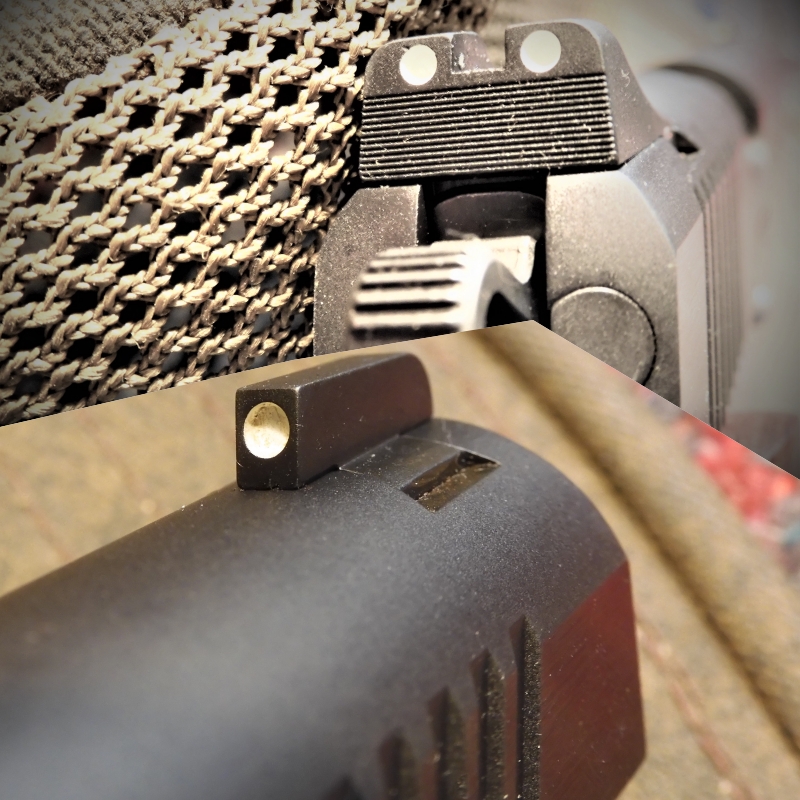
Atop the slide sits two sights consisting of a two-white dot rear sight and a single white dot front sight that provides a 6.8-inch site radius. Given a choice between a dot-type front sight vs. a fiber front sight, I will always go for the dot-type. The dots are healthy in size and easy for my eyes to see. The rear sight, however, is a sloped-type that negates racking the slide using a belt or hard surface and is serrated below the two-dots to reduce glare.
The ‘edged’ rear sight seems to be gaining favor these days for those ‘tactical types’ and can be found on the Springfield Armory Ronin, but the front sight on the Ronin is of the fiber type, and this is one reason for my choice of the Kimber Custom II. Both front and rear sights are fixed but drift-adjustable for windage (or removal), with the rear sight additionally secured with a set screw. A set of night-sights may eventually be mounted but the current arrangement works for me. The rear of the slide also receives a flat finish that blends with the rear sight and also aids in cutting glare.

Angled slide serrations are front and rear and this bothers me not as long as I can grip them securely, which I can. I find myself using the front slide serrations for releasing the slide more than the rear, as my hand seems to have more leverage pulling the slide to the rear over using the rear serrations.
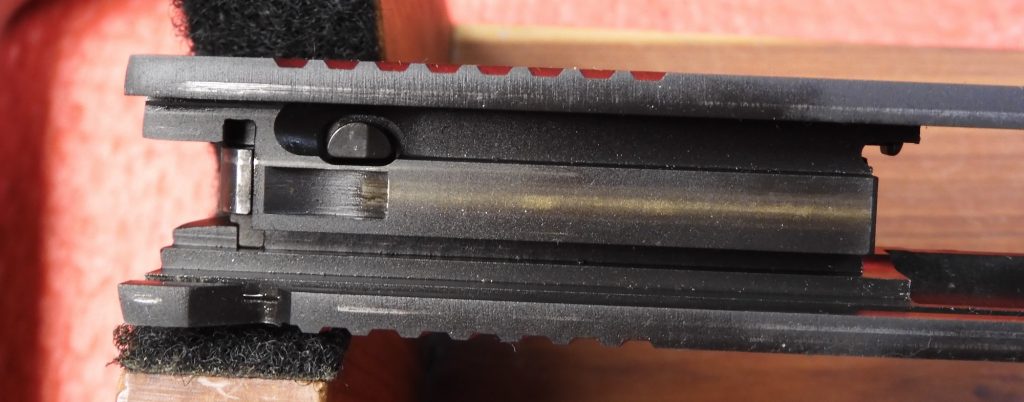
Looking at the inside of the slide, one who is in the know will quickly realize that the Kimber Custom II is based on the ‘80’ series 1911, which means that it has addition of a firing pin block safety. On the Series 80, a pivoting link is actuated by the trigger pull, pushing the firing pin block up and unblocking the firing pin. Thus, the firing pin can only move IF the trigger is pulled (along with pressing the grip safety and deactivating the thumb safety). The Springfield Armory Ronin is also based on the series ‘80’ design. I prefer the ‘70’ series but I have both and have no complaints with either. Because a 1911 is a Series 80 does not mean that it will be defenestrated in any form or fashion.

There is absolutely no play between slide and frame regardless of the slide’s position, which means that proper lubrication is necessary. Kimber provides direction on what and how to lubricate for proper operation.
Slide markings consist of the usual left-side Kimber logo with Custom II on the frame’s right side.
With the exception of the angled slide serrations and other cuts that require a sharp edge, the slide has all edges smoothed out, and despite the contrast, blends well with the frame.
Barrel and Stuff
Adding further contrast to the slide is the standard-style stainless-steel barrel (match-grade?) and guide rod bushing. The guide rod is of the full-length type that has caused a sometimes-contentious debate among 1911 owners. The ejection port has been flared and lowered, which is common to all modern 1911 pistols other than GI clones. As with most 1911-based pistols, the extractor is internal and seems to be adjusted properly (as checked with my Weigand extractor tension gauge). It has been stated that JMB favored the external extractor but the U.S. Army wanted an internal extractor to eliminate problems in the field, but I have found nothing to verify that. The ejector is still part of the frame so nothing to report here in that regard. Both extractor and ejector work quite well, thank you.
Integrated into the barrel’s chamber is an inspection port, which is becoming more common on 1911s, which allows you to see if the chamber is occupied or not.
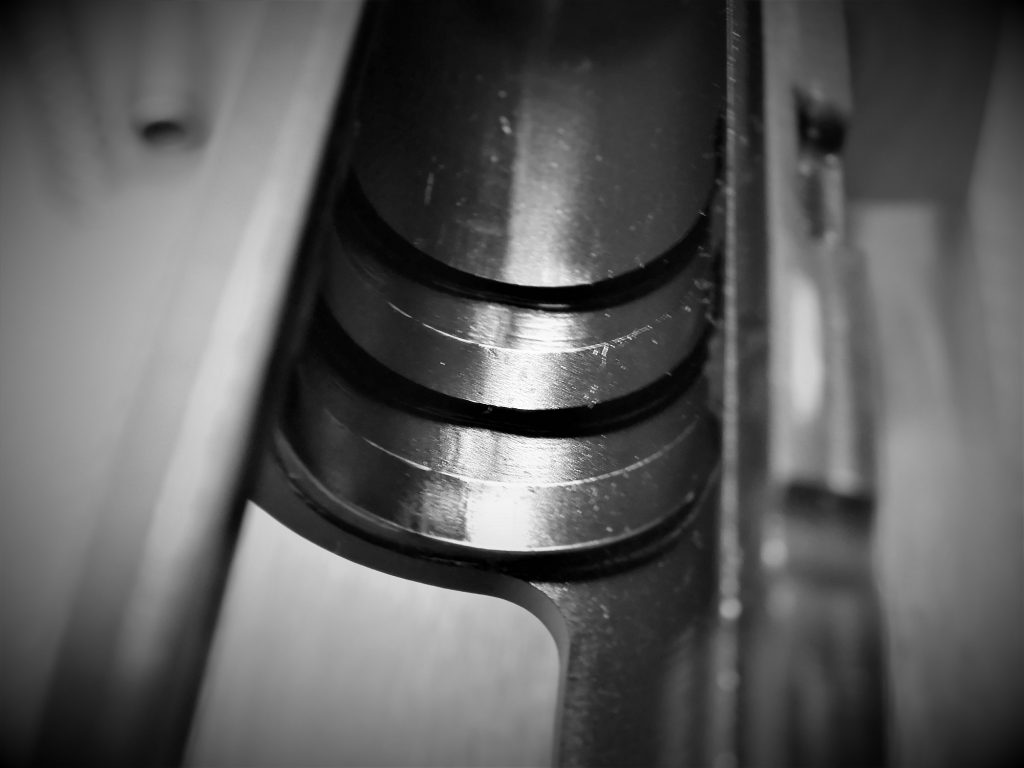
Barrel locking lugs are well-cut and defined that are used to lock-up the standard stainless steel, match grade left-handed 1:16 twist rate barrel that is sliding through a stainless-steel match grade bushing. The barrel is identified on top of the chamber area as .45 ACP in case you forget what caliber you are shooting.
The recoil spring is 16-pounds (according to Kimber) and you will definitely use the slide serrations to move the slide to the rear, and you will also need a bushing wrench (a polymer unit is provided) to disassemble the pistol for maintenance, as the barrel to bushing fit is tight, very tight when the unit is new and out of the box.
It’s a Frame-up!
The side of the frame is polished, which is different from other examples of the Custom II that I have seen, and adds yet another contrast to the pistol. The remainder of the frame is brushed satin stainless-steel. The controls (trigger, thumb safety, slide stop, and grip safety/beaver-tail safety) receive the brushed satin finish, which in addition to the slide tones makes the Kimber Custom II a five-tone rather than a duo-tone. The skeletonized hammer is the common roiled, ‘commander’ type as is found on most 1911-based pistols of the day. The hammer is polished on the sides and has a black hammer spur.
The beaver-tail grip safety is always welcomed by my hand on a 1911 and the shape of the safety ensures that the hand, regardless of how high up on the grip, positively engages the grip safety.
The thumb safety is left-side only as JMB designed it. The thumb safety is extended for positive interaction by the operator and is usually where you find my thumb during firing.
The plunger tube is staked, as is found on the majority of 1911 pistols (Ruger being the only exception that I know of).
The mainspring housing is standard flat with checkering and is constructed of composite material (as most are these days). I have come to like the arched mainspring housing of the 1911A1 and this one will be replaced with one. The slightly extended and textured (more than a basic GI model) magazine release button is located on the left side of the frame in its expected position. The magazine well is slightly beveled for positive insertion of a magazine that, incidentally, exits the butt very well after pressing the magazine release button. The front strap of the grip, however, is smooth and devoid of checkering or grooving for a finger-hold.
Providing a cover for the frame cutouts where the magazine resides are two smooth/checkered, standard-width rosewood panels with brushed stainless-steel grip screws. They not only look great but have enough checkering to keep the hand in place during operation. Speaking of a magazine, the Kimber Custom II comes with one stainless-steel 7-round magazine with the Kimber logo stamped in the bottom as well as holes drilled for mounting a ‘slam pad’ if one desires. This guy, however, usually desires to use magazines other than the provided Kimber magazine.
Unlike the polymer trigger on the SA Ronin, the trigger is an aluminum, three-hole long-trigger unit. Brand new, the trigger pull comes in at 5 pounds, 2.1 ounces with a five-pull average from my Lyman digital trigger pull gauge with three out of five pulls measuring 4 pounds, 11 ounces. As with most 1911-based triggers, there is a slight take-up, the wall, and a very crisp trigger break. There is a slight hint of grittiness between the engagement point of the trigger and when the sear releases from the hammer, but the Kimber Custom II is brand new and that grittiness will go way eventually with use. There is also an over-travel adjustment that, with this 1911, was adjusted properly as there is no trigger over-travel.
The hammer spring, as with the recoil spring, is substantial when new. The hammer does have the “safety notch” or sometimes referred to as the ‘half-cock’ position. In this position the sear will not release (the hammer will not fall) even if the grip safety and thumb safety set to the firing positions (in and down).
The frame is relieved of material around the trigger area (reflection of 1911A1 heritage) to allow easier access by the trigger finger.
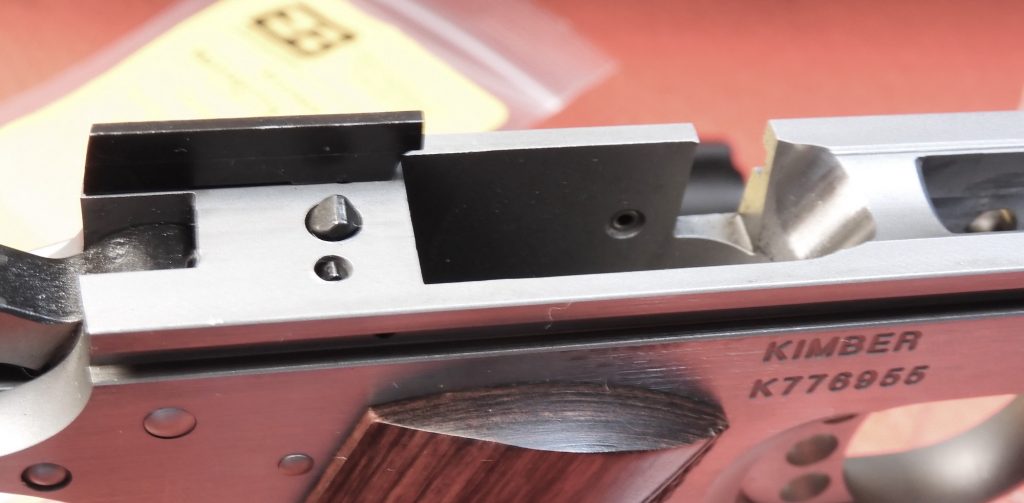
Machining on the interior of the frame is excellent with nary a machine mark present. No markings exist on the left side of the frame while Kimber, the serial number, and origin of manufacturer (Yonkers, N.Y USA) is present on the right side of the frame.
The exterior of the frame has the same blended application as the slide to smooth the lines.
By the way, and according to Kimber, the slide, frame, and barrel bushing are all hand-fitted.
MIM (Metal Injection Molding)
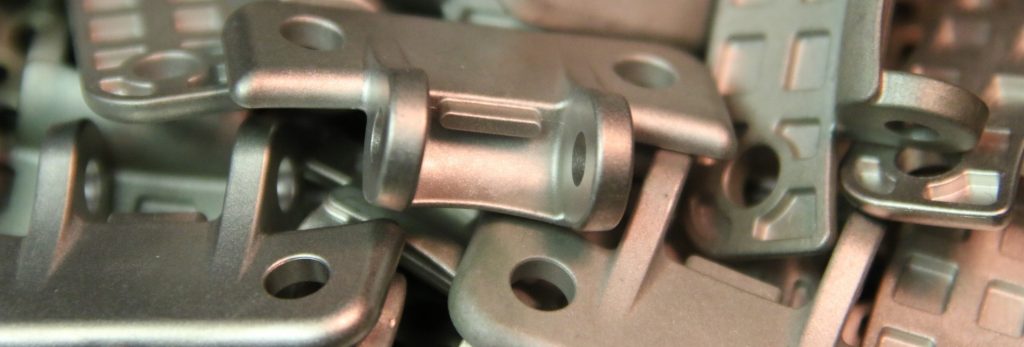
I have read many on-line posts regarding the use of MIM parts in pistols and most posts reflect negative feelings regarding the use of MIM parts. I’ll just say that, yes, Kimber uses MIM parts, as do many pistol manufacturers. I don’t believe that I have any firearm without MIM parts installed. Let me say this about MIM parts; If the metal powder used for MIM parts is poor quality, the parts are going to be poor quality. Likewise, cast, forged or machined parts made from bad stock will also be poor quality. To sum up, it doesn’t actually matter if the garden variety gun uses MIM parts so long as the manufacturer employs good quality controls and the molding was dialed in correctly. For example, Dan Wesson 1911 pistols are claimed to be MIM free and the difference in cost between a DW 1911 and others is quite evident. Custom gun makers create firearms with hand fitted, very close tolerance, non-MIM parts and the price of doing so is reflected in the cost (and perceived quality). In short, there are no guarantees that a part will not break; MIM, cast, forged, machined and hand-fitted or not. I have shot many a firearm with MIM parts installed. While I may experience an out of spec part at times, I have not (yet) had a MIM part fail.
Lubricating the Kimber
The Kimber Custom II has been inspected, cleaned, and prepped (lubricated) according to Kimber guidelines.
Use a premium lubrication product such as Choice FP-10 or similar quality oil. Grease is not recommended. If the lubrication product contains Teflon, shake well before using as the Teflon settles.
Lubricate the following parts:
- Slide and frame rails; 3 drops on each side.
- Disconnector on top of frame; 1 drop.
- Barrel hood; 2 drops spread across surface.
- Barrel locking lugs inside slide and on barrel; 1 drop on each lug.
- Barrel link; 1 drop behind link.
- Slide stop pin; 1 drop spread across surface.
- Outside of barrel; 3 drops spread across surface.
- Cocked hammer; 1 drop in between the hammer and frame.
- Guide rod; 1 drop spread across surface.
For lubrication these days, I have been using a couple of products from Wilson Combat: Ultima-Lube II Universal, and Ultima-Lube II Oil. Ultima-Lube II Universal is heavy enough to stick where you apply it, and that translates for good use on moving parts such as slides and barrel components to include, swing links and bushings. I like to use the Ultima-Lube II oil on other parts such as hammers pivots and such. On a precision-made firearm like the Kimber, a light oil is best when breaking in or otherwise.
Concealment
As has been stated many times before, the 1911 is one of the easiest to conceal due to its thinness and the Kimber Custom II is no exception.
The RIA 1911 FS Tactical was normally carried in a Kybrid holster from Black Arch holsters and had seen its share of removal and insertion during its time. The Kimber Custom II, however, is to be housed in the Falco A112 IWB holster that wraps this little jewel in all leather. Will the Kimber Custom II experience holster wear? Of course, it will. But it is a gentler wear that Kydex can’t achieve.
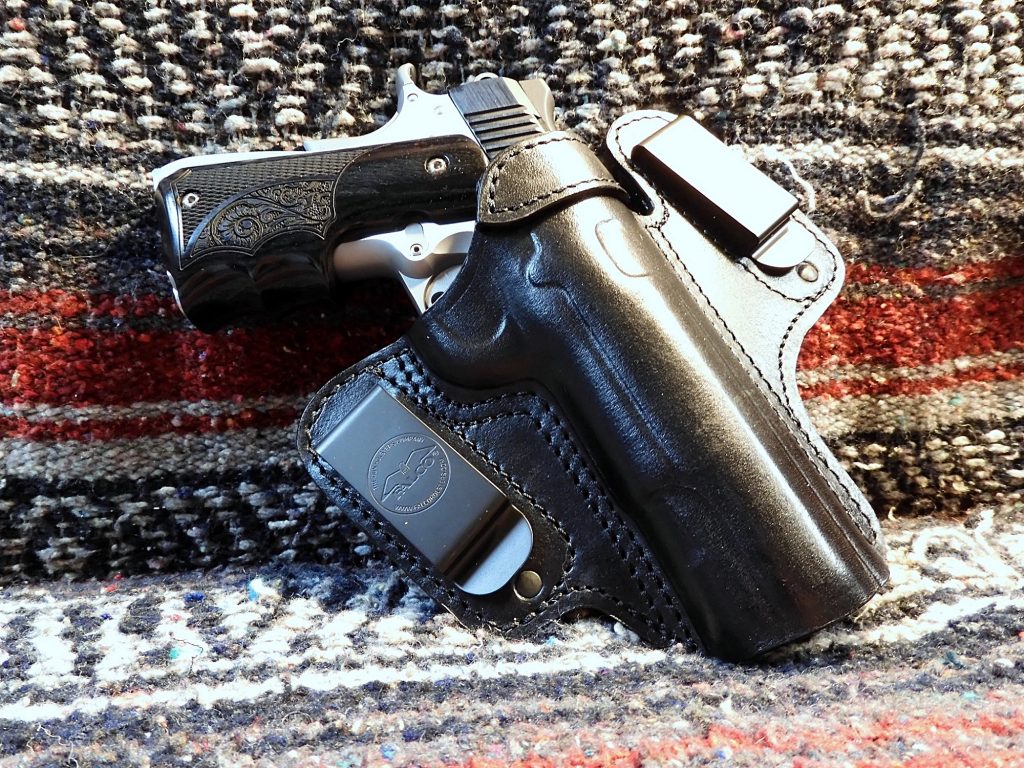
Upgrades

I have come to like the 1911A1 arched mainspring housing on my carry 1911-based pistols in ‘Government’ and ‘Commander’ flavors. The flat polymer mainspring housing that comes with the Kimber Custom II is checkered. Unfortunately, an arched checkered mainspring housing is impossible to find and I opted for a serrated one from Ed Brown in stainless-steel and simply swapped the internals from one to the other. The serrations of the main-spring housing at least somewhat matches those on the slide.
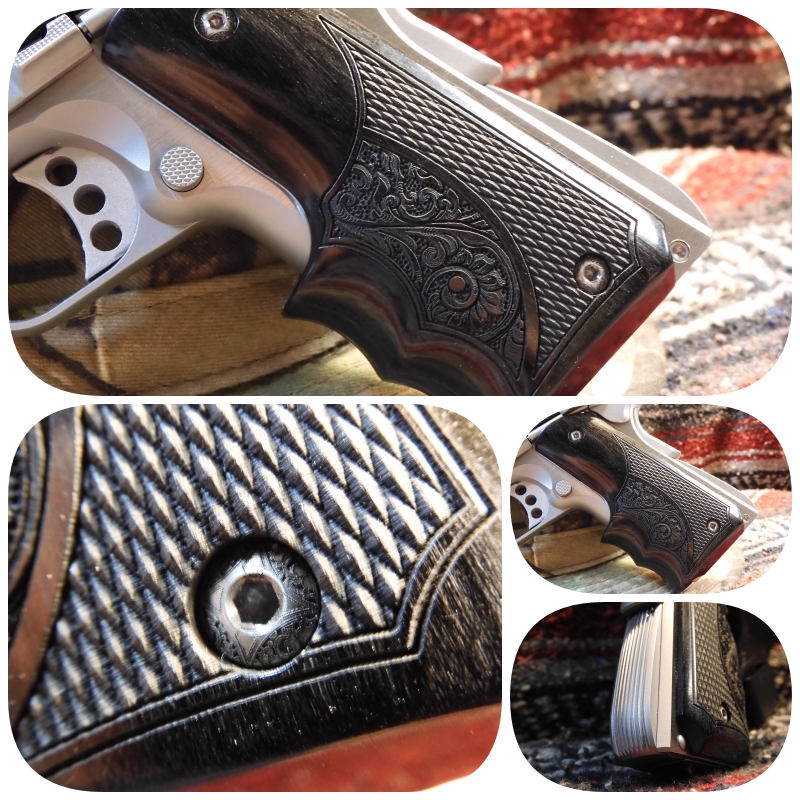
The other upgrade, and although I do like the looks of the grips panels that came with the pistol, was to replace them with a set of 1911 Govt. Fingergroove Silverblack Checkered Engraved grip panels and stainless-steel ‘Royal’ grip screws from Altamont Grips . These grips simply fill my hand better, provide a more positive grip and that provides a bit more control of the pistol. These grips, while seemingly wide, are not wider than standard grip panels, and are less obtrusive compared to other grips that press against the side of my body when the pistol is in an IWB holster. (Author’s Note: Expect 4 to 6 weeks lead time after ordering.)
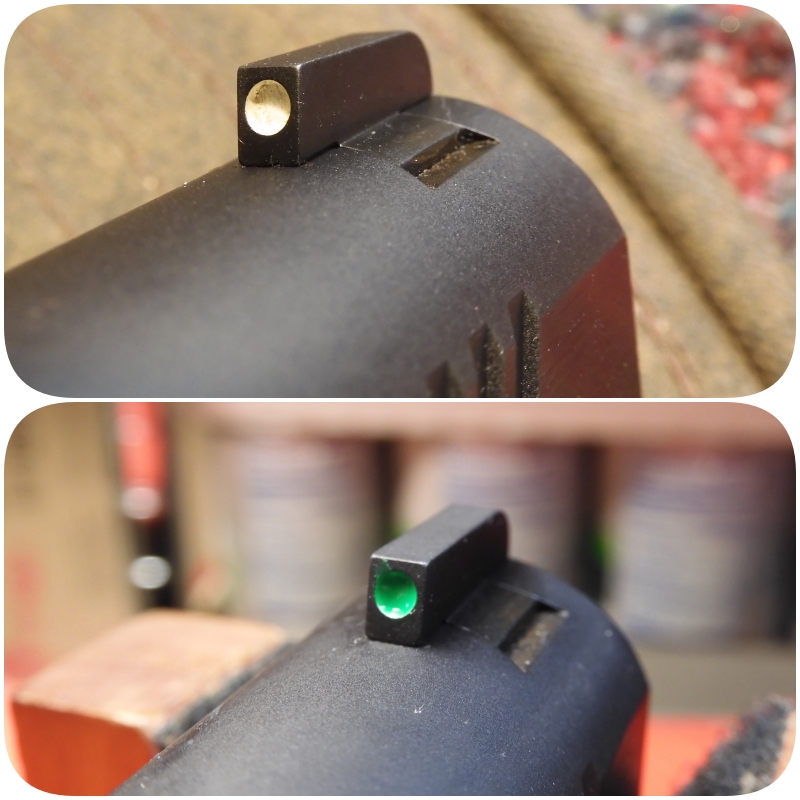
The white three-dot sight arrangement is just fine for me, but a dab of high-visibility fluorescent green paint on the front sight dot makes it even finer and easier to find.
Final Analysis

I have carried quite a few 1911-based pistols in my time. Regardless of caliber I keep finding myself drawn to the design of this old warhorse, but it’s not out of nostalgia. The Kimber Custom II would be just another tool to some, but it is more than a tool to me. It is to become my personal defense companion, a companion that is carried everyday just in case I must rely on something to stand between me and a threat to my existence. And, like humans and any mechanical device that requires human intervention, it requires tuning every now and then along with proper care and maintenance.
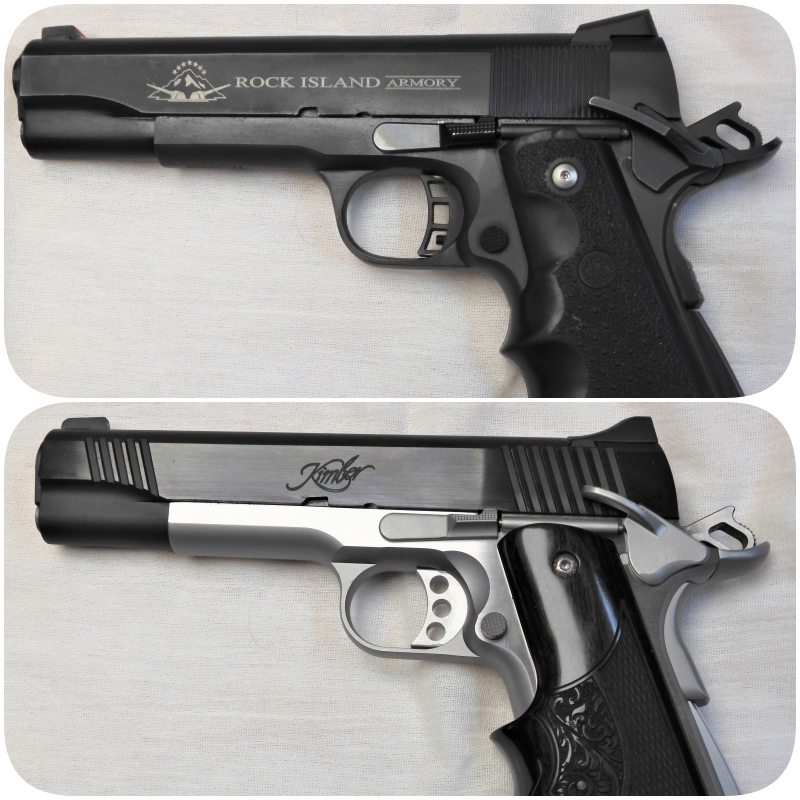
Will the rookie come to replace the old veteran that has been relied on for many years? I have, what I call, samples of three generations of Armscor (Rock Island Armory) 1911-based pistols. While slide markings have changed between generations, the function of the RIA 1911 has not; Rock Island Armory 1911-based pistols continue to be an excellent value for a bargain-basement price. The RIA line of 1911 pistols can be much more than just ‘range shooters’ if you wish them to be. My (second generation) Rock Island Armory (Armscor) 1911 FS Tactical has been my primary PDA for many years. It’s simply time to relegate it to other duties.
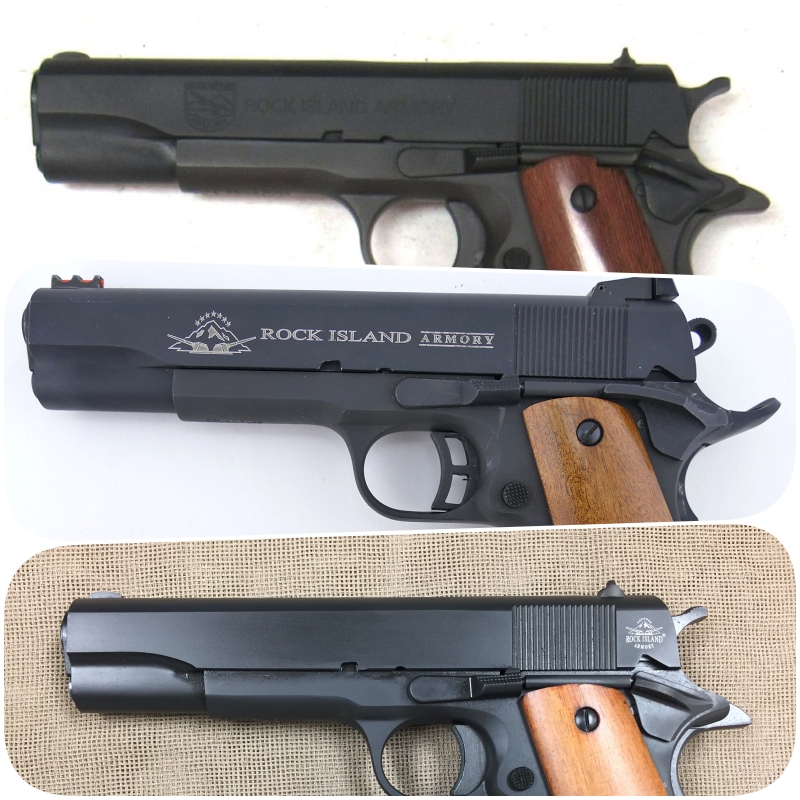
While I say that I do not care for a two-tone pistol, I won’t say that I won’t carry or shoot one, as evident by having several (Ruger SR9, SR9C, SR45, SR1911 Lightweight Commander-Style in .45ACP and SR1911 Lightweight Commander-Style in 9mm). I prefer all black or all stainless-steel and have more than my share of both. The Kimber Custom II is, in all sense, an excellent looking and performing 1911-based pistol without being glitzy or faddish. The Kimber Custom II, obtainable at less than the MSRP of $910, is also within reach of most budgets for those looking for their first 1911-based pistol or more experienced 1911 operators, like myself, who just enjoys the 1911, its lines, its function, and finally…its heritage.
UPDATE 09/24/2021
When I installed the wrap-round grips from The Altamont Company, I neglected to notice that they were for a 1911 with ambidextrous thumb safety, which meant that there was a gap where a right side safety lever would be mounted. So it was off to trade the grips out. Luckily The Altamont Company came through with an excellent set of replacement wrap-around grip panels with an outstanding laminate pattern.
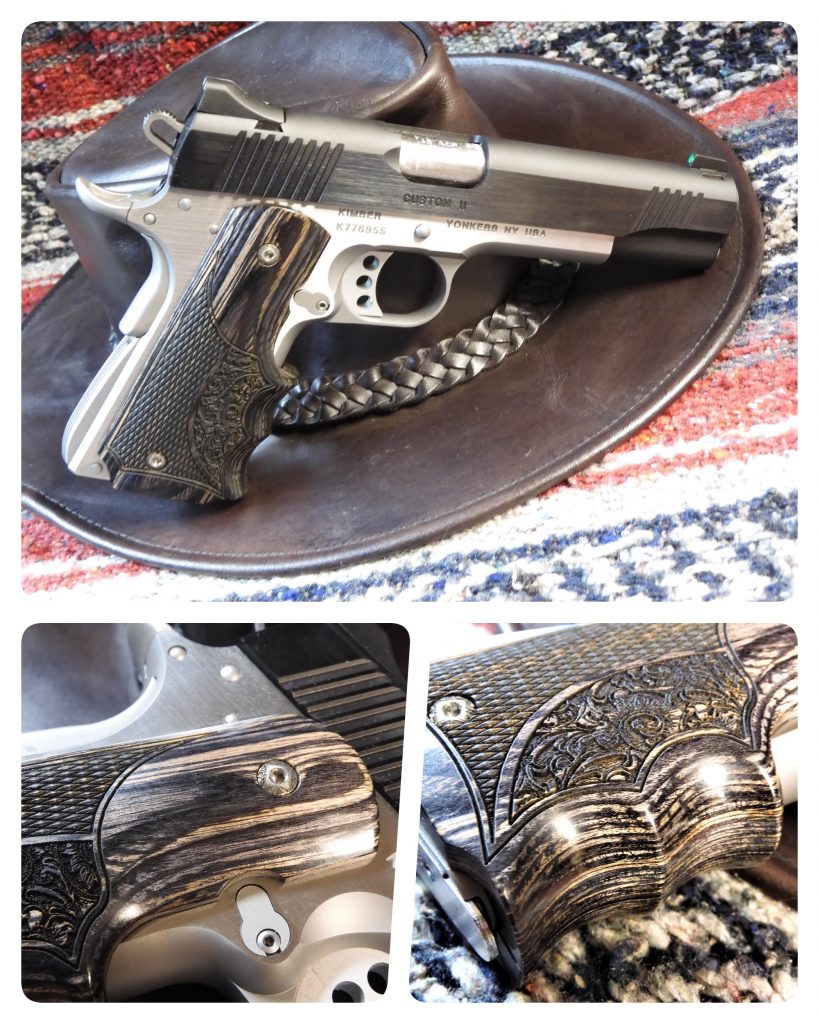
The previous set of 1911 Govt. Fingergroove Silverblack Checkered Engraved grip panels were exchanged with a different version of the same-type grip and one without the ambidextrous safety cut. The number of layers to create this unique grip adds an outstanding and unique look to the Kimber Custom II.
In Closing
Kimber has been providing near-custom 1911-based pistols for many years. One will find the fit and finish of their pistols are of high quality and the Custom II does not deviate from that, although it is considered a ‘budget-priced’ firearm.
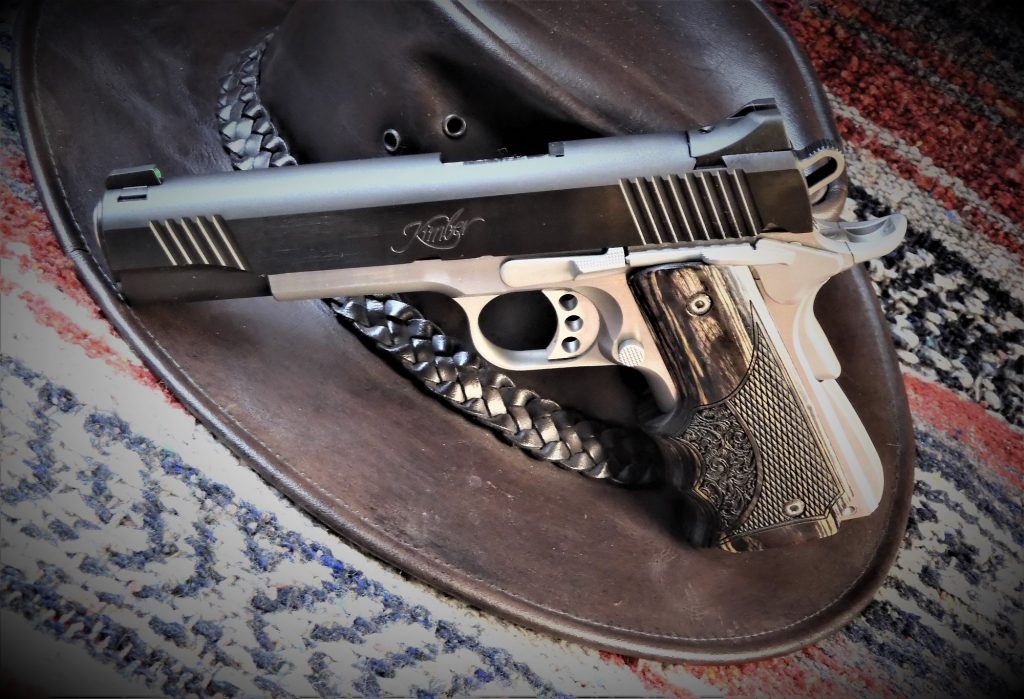
Resources
I always like to include resources for you to research that provide alternatives to my own input about a firearm; the first is from Kimber and the remaining from YouTube ‘tactical’ warriors who’s presentations always fill me with wonder regarding their dramatics.
- Custom II (Two-Tone)
- KIMBER CUSTOM II 1911: overview & shooting
- Kimber Custom II 1911 45 ACP 1000 round Review!!
- Kimber Tactical Custom II: Shelf Piece
- Kimber Custom II Two Tone – Best 1911 for the money (hands down)
- The Kimber 1911 Custom II: The peace maker
![]()

